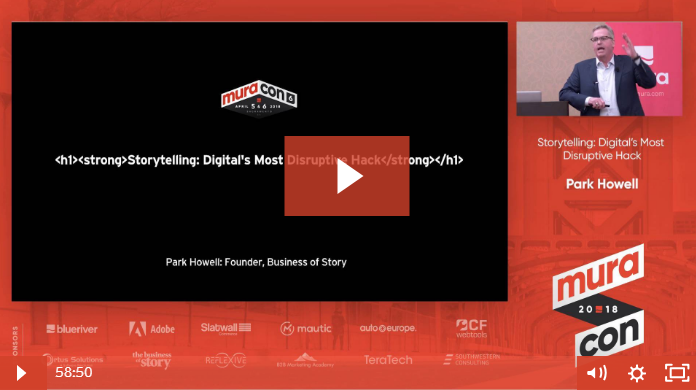Think for a moment about some of the top brands and businesses out there, big names like Apple, Facebook, Elon Musk and Phil Knight. How did they get to where they are today? Chances are garages, dorm rooms and bold ideas start coming to mind.
One thing so many successful businesses (and business people) have in common is that they have a good story behind them. After all, the Facebook founding story of Mark Zuckerberg is so compelling that a major movie was made all about it. According to business strategist Park Howell, this is not by accident. In his recent keynote address at MuraCon 2018, he noted that everyone in the enterprise benefits from understanding the power of storytelling. Even developers.
According to the CEB, potential buyers are now 57 percent of the way through their own customer journey before they ever talk to a sales rep.
Most organizations now understand the need to use digital experiences and touchpoints to connect with customers and peers. But, without a compelling story underpinning it all, it can be difficult to effectively do all that, especially if the topic or subject matter isn't simple. How do you create something that resonates well enough to be remembered? How do you ensure your website is built in a way that facilitates good communication and not get in the way? How do you get peers on your side when pitching ideas and projects?
Breaking through the clutter
We all know the web is the default when researching just about anything. According to the CEB, potential buyers are now 57 percent of the way through their own customer journey before they ever talk to a sales rep. There's so much helpful and useful information out there that customers don't need to pick up a phone in order to learn about their issues and how they can be resolved.
As a result of this, many brands have rushed to embrace content marketing, to ensure their own perspective is included in these research efforts. Over nine out of every 10 businesses are now investing in content marketing to some degree, according to some reports.
For millennia, humans have told each other stories, and so that's often how most of us effectively process and comprehend our modern world.
But, just because you're investing in content marketing doesn't mean it will work well. With so much information out there, potential buyers have become savvier. No one wants to waste their time with boring or lackluster content, or with a clunky website.
This doesn't just apply to business messaging. Think about the last meetings you sat through, where nothing was accomplished and people just talked around each other, or the last resume you read where it's hard to determine what that applicant actually brings to the table.
Why stories work
To communicate effectively, it helps to have an understanding of how our brains process information, Howell noted. For millennia, humans have told each other stories, and so that's often how most of us effectively process and comprehend our modern world.
Don't believe us? Just consider the Heider Simmel animation for a moment:
What did you see? Did you see bullying, mutual aid or just shapes randomly moving around a screen? Even in situations where there seemingly isn't a story, our brains default to story mode to make sense of it all - and of the world around us. It's true in abstract animations, and it's true in business too. Even as technology evolves at a rapid clip, our brains are still, in many ways, hard-wired to comprehend situations in the same way our hunter-gatherer ancestors tried to understand the world: through stories.
As the masses have become the media, it doesn't make sense to bombard them with business-centric information they don't really care about. As Howell noted, the antidote to all of this is the anecdote. Brands that successfully leverage the power of story are ones that can better talk to and reach their target buyers through all channels, including the website, and ultimately convince them to become customers.
This works just as well on the individual level, too. Successful entrepreneurs and business leaders like Sheryl Sandberg use stories to convey their ideas, and it's something developers, marketers and others should heed in their next "frivolous" meeting.
So how do brands and individuals actually go about crafting effective stories that stick, and how do they ensure the right story is told on the site and in their jobs? We'll answer that and explore Park Howell's secret sauce for success in an upcoming article here on the Mura blog.
More from Blueriver
[Video] Storytelling, Digital's Most Disruptive Hack
 As the masses have become the media, it's increasingly difficult for brands and individuals to cut through the noise.
As the masses have become the media, it's increasingly difficult for brands and individuals to cut through the noise.
So, what's the antidote? According to noted business storyteller and author Park Howell, it's the anecdote. By using our natural proclivity for storytelling, anyone can more effectively get their message across and be more effective in marketing, web development or anything else.
In this MuraCon keynote presentation, Park explains what make and effective story that sticks, and how to ensure the right story is told.
Additional Resources
Storytelling Part 2 of 2:
getmura.com/blog/storytelling-how-anyone-can-effectively-tell-their-own-story-and-cut-through-the-noise
More from Park Howell:
getmura.com/blog/how-storytelling-soft-skills-can-create-better-user-experiences-in-technical-careers